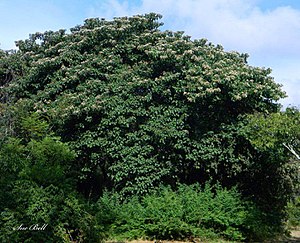Cordia africana
| Cordia africana | ||||||||||||
|---|---|---|---|---|---|---|---|---|---|---|---|---|

Cordia africana |
||||||||||||
| Systematics | ||||||||||||
|
||||||||||||
| Scientific name | ||||||||||||
| Cordia africana | ||||||||||||
| Lam. |
The Cordia africana is a plant of the genus Kordien ( Cordia ) in the family Boraginaceae (Boraginaceae). It is native to tropical Africa .
description
Appearance and leaf
Cordia africana is a deciduous, fast-growing tree that can reach heights of up to 25 meters. The tree trunk usually branches a few meters above the ground. The treetop is expansive. The bark is gray to dark brown with flat cracks. The bark of both young twigs in particular is partially or noticeably hairy. The mostly alternate leaves are stalked (1.5 to 10.5) mostly 2 to 10 centimeters long. The simple, stiff leathery leaf blades are 6 to 21 centimeters long and 4 to 16.5 centimeters wide, ovate to broadly ovoid, sometimes elliptical to almost circular with an almost pointed or heart-shaped and often asymmetrical blade base as well as rounded and sudden short tapered or sometimes pointed upper end. The leaf margin is smooth or only slightly notched. The undersides of the leaves are brownish hairy. There are five to seven lateral nerves, raised on the underside of the leaf, on each side of the median nerve.
Inflorescence and flower
The flowers are arranged in broad, umbrella-like inflorescences . The flower stalk is about 1 millimeter long.
The hermaphroditic flowers are radial symmetry and five-fold with a double flower envelope . The leathery sepals are fused into a 7 to 9 millimeter long and at the opening 4 to 7 millimeter wide tube, which has three to five calyx teeth and sometimes splits into two calyx lips. The 17 to 21, sometimes up to 24 millimeters long and white petals are funnel-shaped fused with a 15 to 19, sometimes up to 22 millimeter long corolla tube and 1.5 to 3.0 millimeters long and 10 to 13 (up to 15) millimeters wide Crown lobes. The stamens are set 3 to 5 millimeters from the base of the corolla. On a 7 to 10 millimeter long filament there is a 2 to 2.5 millimeter long anther. The sweet smelling flowers provide bees with rich nourishment. The bald, top permanent ovary is egg-shaped with a length of about 2 millimeters and a diameter of about 1.5 millimeters. The stylus is 13 to 18 millimeters long and forks 7 to 12 millimeters from the ovary, the area with scar tissue is 1.5 millimeters long.
Fruit and seeds
The relatively small and when ripe yellowish to dark brown stone fruit is about 12 millimeters long and about 8 millimeters in diameter ovate to ellipsoidal or obovate and ends in a short tip. The fruit is enclosed at the base by a hairy cup (the calyx) and usually contains one to two, rarely up to four seeds. The pulp is edible.
distribution
The home of the Cordia africana is in tropical to subtropical Africa . Their distribution area extends from Ethiopia and Sudan through Kenya , Tanzania , Uganda , Burundi , Rwanda , Zaire , Guinea and Nigeria south to Angola , Malawi , Mozambique , Zambia , Zimbabwe and in the north of the South African Transvaal . The distribution area also includes an occurrence in Yemen on the Arabian Peninsula .
use
The Cordia africana provides valuable timber that is relatively resistant to termite and fungal attack. It is used, among other things, for furniture, tool handles and water containers as well as for window frames in exterior construction. The wood is light brown to brown. The bulk density (fresh) is around 750 kg / m³, the bulk density (HF 12%) 440–580 kg / m³. It is also used as firewood.
For this purpose, the fruits are consumed by humans and the leaves are used as fodder. The bark and roots also have medicinal uses.
Cordia africana is sometimes planted specifically as a shade tree for agricultural crops of crops such as maize.
Taxonomy

The first publication of Cordia africana was in 1792 by Jean-Baptiste de Lamarck in Tabl. Encycl. , 1, p. 420. For a long time, however, the synonym Cordia abyssinica R.Br. in use. Starting with Georg Cufodontis in 1961, other botanists such as Heine 1963, Taton 1971 and Troupin 1982/1985 also used the name Cordia africana . Another synonym is Cordia holstii pickle .
swell
- ES Martins: Boraginaceae in Flora Zambesiaca , Volume 7, 1990: online at KEWScience (section description).
- Description in the Famine Food Field Guide . (engl.)
- Entry at FAO ( Memento of November 29, 2018 in the Internet Archive )
Individual evidence
- ↑ Diriba Nigusie Debele, 2006: Crop Yield Assessment in Traditional Cordia Africana Lam. - Tree Intercrop Based Farms in West Wellega .
- ^ Salt, Voyage to Abyssinia, app. LXIV, 1814.
- ↑ AM Warfa: Cordia africana Lam. (Boraginaceae), the Correct Name for Bruce's "Wanzey" . In: Taxon . tape 37 , no. 4 , November 1988, pp. 961-963 , doi : 10.2307 / 1222119 , JSTOR : 1222119 .
- ↑ HGA Engler: The flora of East Africa. Theil C, 1895, p. 335, online at biodiversitylibrary.org.
Web links
- Entry at GRIN - Taxonomy for Plants . (engl.)
- Cordia africana Useful Tropical Plants.
